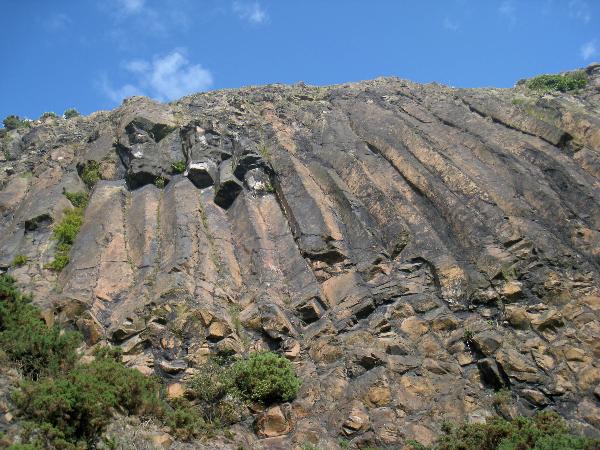
Holyrood Park is a royal park in
central Edinburgh, Scotland. It has an array of hills, lochs,
glens, ridges and cliffs within its 650 acre area. The park is
associated with the royal palace of Holyrood House, and was
formerly a 12th-century royal hunting estate, although it is now
publicly accessible.
Basalt is an Igneous rock. Igneous rocks
(etymology from Latin ignis, fire) are formed by magma (molten
rock) being cooled and becoming solid. They may form with or
without crystallization, either below the surface as intrusive
(plutonic) rocks or on the surface as extrusive (volcanic) rocks.
This magma can be derived from partial melts of pre-existing rocks
in either the Earth's mantle or crust. Typically, the melting is
caused by one or more of three processes: an increase in
temperature, a decrease in pressure, or a change in composition
such as an addition of water.
Over 700 types of igneous rocks have been described, most of them
formed beneath the surface of the Earth's crust. These have diverse
properties, depending on their composition and how they were
formed.
Igneous rocks make up approximately 95% of the upper part of the
Earth's crust, but their great abundance is hidden on the Earth's
surface by a relatively thin but widespread layers of the two other
rock types.
Igneous rocks are geologically important because:-
-
their minerals and global chemistry give
information about the composition of the mantle, from which some
igneous rocks are extracted, and the temperature and pressure
conditions that allowed this extraction, and/or of other
pre-existing rock that melted;
-
their absolute ages can be obtained from various
forms of radiometric dating and thus can be compared to adjacent
geological strata, allowing a time sequence of events;
-
in some special circumstances they host
important mineral deposits (ores): for example, tungsten, tin, and
uranium are commonly associated with granites and diorites, whereas
ores of chromium and platinum are commonly associated with
gabbros.
Basalt is a common extrusive volcanic rock. It is usually grey to
black and fine-grained due to rapid cooling of lava at the surface
of a planet.
The most common uses for this rock are as aggregate in highway
construction, railroad ballast, and tile. Basalt is also a major
component of asphalt.
On Earth, most basalt magmas have formed by decompression melting
of the mantle. Basalt has also formed on Earth's Moon, Mars, Venus,
and even on the asteroid Vesta. The crustal portions of oceanic
tectonic plates are composed predominantly of basalt, produced from
upwelling mantle below ocean ridges.
During the cooling of a thick lava flow, contractional joints or
fractures form. If a flow cools relatively rapidly, significant
contraction forces build up. While a flow can shrink in the
vertical dimension without fracturing, it cannot easily accommodate
shrinking in the horizontal direction unless cracks form; the
extensive fracture network that develops results in the formation
of columns. The topology of the lateral shapes of these columns can
broadly be classed as a random cellular network. These structures
are often erroneously described as being predominantly hexagonal.
In reality, the mean number of sides of all the columns in such a
structure is indeed six (by geometrical definition), but polygons
with three to twelve or more sides can be observed. Note that the
size of the columns depends loosely on the rate of cooling; very
rapid cooling may result in very small (<1 cm diameter) columns,
while slow cooling is more likely to produce large columns.
(Notable columnar basalts include :-
IMPORTANT
In order to log the cache
1. Estimate the length of the longest column.
2. Estimate the entire width of all of the columns. (I started at
the beginning of the fence and ended up just above the large fallen
boulder below the road and paced this out).
3. Igneous rock is one of the three main rock types. What are the
other two?
4. Take a photo of yourself with GPSr and the outcrop clearly in
view and upload with log.
Once you have the answers please e-mail me this
info (Do not post the answer in your log!!)
Any log that does not fulfil all four
requirements may be deleted.
*****
FTF Well done to Grim Fun
Scenes on first to find
*****